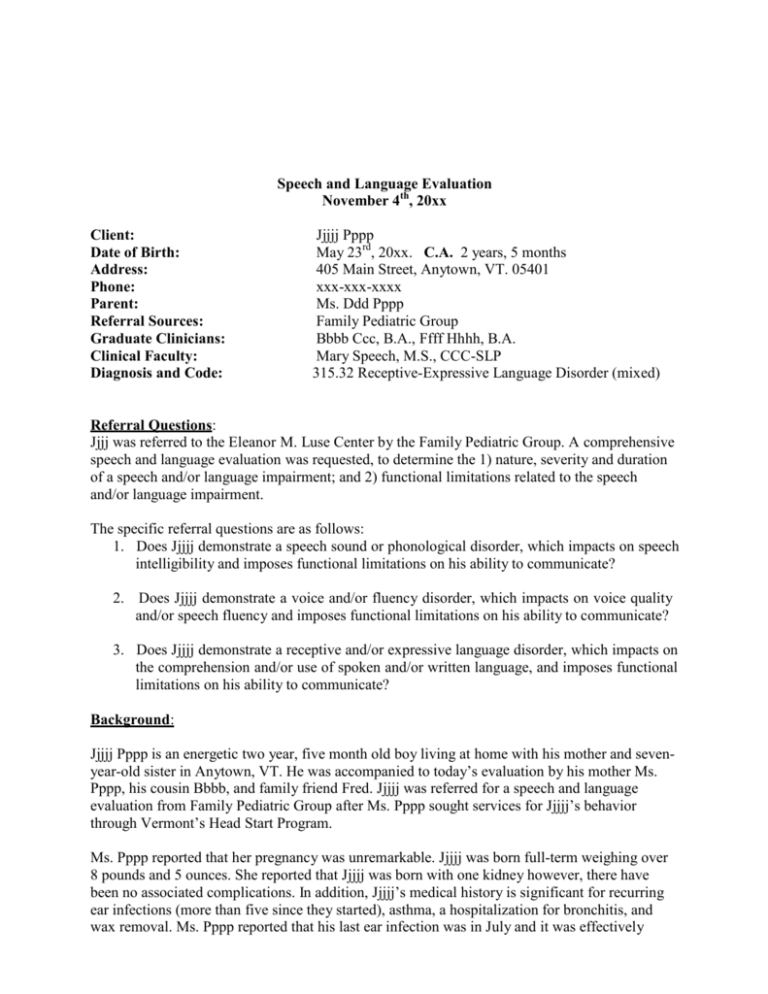The Receptive-Expressive Emergent Language Scale-Third Edition (REEL-3; Bzoch, League, & Brown, 2006) is a norm-referenced caregiver interview that is typically used to screen for emergent language learning problems in both receptive and expressive domains among infants and toddlers up to 3 years of age. Prevalence estimates based on both receptive and expressive language tend to be lower than those based on expressive language alone (13.4% versus 19.1%; Zubrick et al., 2007). Prevalence estimates are higher for children with a positive family history for LLE (23%) compared with those with no reported history (12%; Zubrick et al., 2007 ). Receptive-Expressive Emergent Language Test: Profile/Test Forms, 25 Bzoch, Kenneth, League, Richard on Amazon.com.FREE. shipping on qualifying offers. Receptive-Expressive Emergent Language Test: Profile/Test Forms, 25. The Bzoch-League Receptive Expressive Emergent Language Scale (REEL) has a relatively large number of items for the early ages (132 test items). The test relies heavily on parent report. Subtests include Receptive Language Age, Receptive Quotient, Expressive Language Age, Expressive Quotient, Combined Language Age and Language Quotient.
- Receptive-expressive Emergent Language Scale Free Download
- Receptive-expressive Emergent Language Scale Free Download
- Receptive Expressive Emergent Language Scale Free Download
The Receptive–Expressive Emergent Language Test–Fourth Edition (REEL-4) was designed to help you identify infants and toddlers who have language impairments or who have other disabilities that affect language development.
The REEL-4 has two subtests that make up the Language Ability composite, Receptive Language and Expressive Language, as well as a supplementary Vocabulary Inventory test, composed of the Nouns and Expanded subtests. Results are obtained from a caregiver interview.
The REEL-4 is based on a contemporary linguistic model. It includes current studies related to normative base, reliability, and validity. The normative sample includes 1,019 infants and toddlers from around the U.S.. The demographic characteristics of the sample were matched to U.S. child population for the year 2019 reported in ProQuest Statistical Abstract of the United States 2018. The normative sample was stratified to on the basis of gender, race, Hispanic status, and geographic region. Standard scores, percentile ranks, and age equivalents are provided.
The average reliability coefficients for all test scores are high (exceeding .90). Test–retest studies show the REEL-4 is stable over time.

Studies of the test’s diagnostic accuracy (sensitivity, specificity, and ROC/AUC statistics) support its use for differentiating children with language impairment, low-functioning autism, and developmental delay from children with no exceptionalities. Validity data are reported as well, documenting the test’s relationship to the Developmental Assessment of Young Children–Second Edition, Preschool Language Scale–Fifth Edition, Receptive–Expressive Emergent Language Test–Third Edition, and Test of Early Communication and Emerging Language.
The Receptive–Expressive Emergent Language Test–Fourth Edition (REEL-4) was designed to help you identify infants and toddlers who have language impairments or who have other disabilities that affect language development.
The REEL-4 has two subtests that make up the Language Ability composite, Receptive Language and Expressive Language, as well as a supplementary Vocabulary Inventory test, composed of the Nouns and Expanded subtests. Results are obtained from a caregiver interview.
The REEL-4 is based on a contemporary linguistic model. It includes current studies related to normative base, reliability, and validity. The normative sample includes 1,019 infants and toddlers from around the U.S.. The demographic characteristics of the sample were matched to U.S. child population for the year 2019 reported in ProQuest Statistical Abstract of the United States 2018. The normative sample was stratified to on the basis of gender, race, Hispanic status, and geographic region. Standard scores, percentile ranks, and age equivalents are provided.
Receptive-expressive Emergent Language Scale Free Download

Receptive-expressive Emergent Language Scale Free Download
The average reliability coefficients for all test scores are high (exceeding .90). Test–retest studies show the REEL-4 is stable over time.

Receptive Expressive Emergent Language Scale Free Download
Studies of the test’s diagnostic accuracy (sensitivity, specificity, and ROC/AUC statistics) support its use for differentiating children with language impairment, low-functioning autism, and developmental delay from children with no exceptionalities. Validity data are reported as well, documenting the test’s relationship to the Developmental Assessment of Young Children–Second Edition, Preschool Language Scale–Fifth Edition, Receptive–Expressive Emergent Language Test–Third Edition, and Test of Early Communication and Emerging Language.